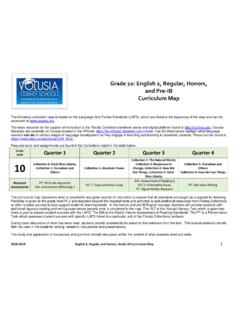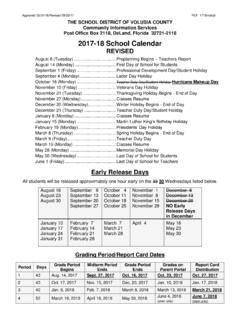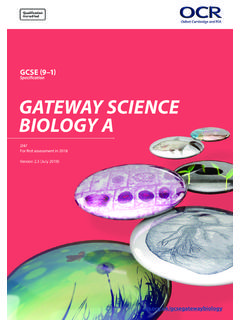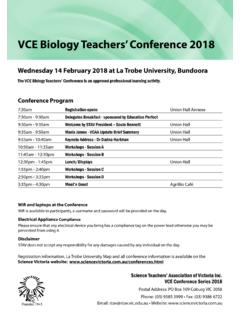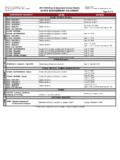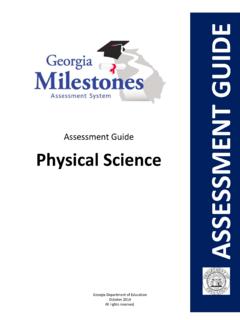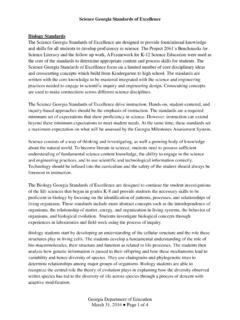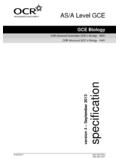Transcription of BIOLOGY EOC STUDY GUIDE with Practice Questions
1 BIOLOGY EOC STUDY GUIDE . with Practice Questions 2012-2013. Volusia County Schools 1. The BIOLOGY EOC. The BIOLOGY 1 EOC assessment is delivered via computer-based test. The assessment is given in one 160 session with a 10 minute break after the first 80. minutes. Any student not finished by the end of the 160 minutes may continue working but, the test must be completed within the same school day. There are multiple forms of the assessment . There is a maximum of 66 multiple-choice items on each test form. Students are provided with four-page, hard-copy work folders to use as scratch paper. Used folders are secure materials that must be turned in after testing. For students entering grade nine in the 2011-12 school year, the EOC will be averaged as 30% of their final course grade.
2 For students entering grade nine in the 2012-13 school year, the EOC must be passed to receive credit for the class. BIOLOGY EOC STUDY GUIDE This STUDY GUIDE was developed by Volusia County teachers to help our students prepare for the Florida BIOLOGY End-Of-Course Exam. The Florida EOC is broken down by the following Measurement Topics (MT) . Molecular and Cell BIOLOGY Classification, Heredity, Organisms, Populations, Ecosystems Evolution 35% of EOC 25% of EOC 40% of EOC. MT 1& 2 The Nature of Science MT 1& 2 The Nature of MT 1& 2 The Nature of Science MT 3 Theories, Laws, Models Science MT 3 Theories, Laws, Models MT 9 Properties of Water, MT 3 Theories, Laws, MT 5 Energy in Ecosystems Macromolecules, Enzymes Models MT 6 Population Dynamics MT 10 The Cell Theory MT 4 Taxonomy MT 7 Human Impact on the Environment MT 11 Cell Structure & Function MT 16 Genetics MT 8 Plants MT 12 Cell Membrane & MT 10 Origins of Life MT 17 Biotechnology Transport MT 18 Evolution MT 20 Fetal Development MT 13 Photosynthesis & Cellular MT 19 Mechanisms of MT 21 Parts of the Brain Respiration Change MT 21 Cardiovascular System MT 14 DNA, RNA.
3 Protein MT 21 Immune System Synthesis MT 15 Mitosis, Meiosis 2. Week 1. EOC Review Cell Theory, Cell Structure, Cell Transport Benchmarks: Describe the scientific theory of cells (cell theory) and relate the history of its discovery to the processes of science Compare and contrast the general structure of plant and animal cells. Compare and contrast the general structures of prokaryotic and eukaryotic cells. Relate structure to function for the components of plant and animal cells. Explain the role of cell membranes as a highly selective barrier (passive and active transport). Summary: You need to know the following: The cell theory and how continuous investigations and/or new scientific information influenced the development of cell theory.
4 How scientific claims are evaluated through scientific argumentation, critical and logical thinking and consideration of alternative explanations, in the context of cell theory. The difference between theories and laws and be able to explain how a theory is developed. The general structures of prokaryotic and eukaryotic cells and how they are alike and different. The general structures of plant and animal cells and how plant and animal cells are alike and different. How the structure relates to the function for the components of plant or animals cells. Structures you need to know are the cell wall, cell membrane, cytoplasm, ribosomes, cilia, flagella, nucleus, nuclear envelope, chromatin, ribosomes, endoplasmic reticulum, vacuoles, mitochondria, Golgi apparatus, chloroplasts, lysosomes To understand the role of the cell membrane as a highly selective barrier that carries out passive and active transport.
5 In addition, you need to differentiate between diffusion and osmosis and those types of transport affect the cells. Additional Support Holt McDougal BIOLOGY Interactive Reader: o Chapter 3, Sections , , , , Everglades BIOLOGY End-Of-Course Review o Pages 67-86. Web Sites: o o 3. Sample Questions Cell Theory 1. Cell theory was first proposed in 1838. Evidence obtained through additional scientific investigations resulted in the current cell theory. Which statement describes a component of the original cell theory that was removed because of the new scientific knowledge? A. All living things are made of cells. B. All cells come from other preexisting cells. C. Cells form through spontaneous generation.
6 D. Cells are the basic structural and functional units of life. 2. Which invention from the 17th century allowed for the development of modern cell theory? A. X-rays B. computers C. the light microscope D. the scanning electron microscope 3. A plant and an animal are both living things. According to the Cell Theory, what can you conclude about these two very different organisms? A. Plants have cells but animals do not. B. They are both made of one or more cells. C. They both come from the same kind of cell. D. They both come from a non-living organism. 4. The combined observations of Mattias Schleiden, Theodor Schwann and Rudolph Virchow resulted in the formation of the cell theory. Which of the following is not part of the cell theory?
7 A. All cells contain a nucleus. B. All cells come from other living cells. B. All living organisms are made of one or more cells. C. Cells are the basic unit of structure and function of all living things. 4. Cell Structure, Function and Transport 1. There are some similarities between prokaryotic and eukaryotic cells. Which of the following structures is found in both prokaryotic and eukaryotic cells? A. lysosome B. mitochondrion C. nucleus D. ribosome 2. Look at the cross section of a cell membrane of a eukaryotic cell. H+ ions are being pumped from a low concentration to a high concentration. How do you describe this type of transport across the cell membrane? A. active transport B. passive transport C.
8 Facilitated diffusion D. co-transport 3. Which type(s) of cells have genetic material that is contained in a nucleus? A. bacteria B. plants only C. animals only D. both plant and animal cells 5. 4. Which characteristic do most plants have in common? A. they are unicellular B. they are prokaryotic C. they produce seeds D. they are autotrophic 5. Which cell structure is correctly paired with its primary function? A. ribosome - protein synthesis B. mitochondrion - movement C. vacuole - cell division D. nucleus - storage of nutrients 6. The diagram below represents a cell of a green plant. Solar energy is used to produce energy-rich compounds in which structure? A. A. B. B. C. C. D. D. 6. 7. A person with swollen gums rinses his mouth with warm salt water, and the swelling decreases.
9 Which of the following has occurred? A. The swollen gums have absorbed the saltwater solution. B. The saltwater solution lowers the temperature of the water in the gums. C. The salt in the solution has moved against the concentration gradient. D. The water in the gums has moved out due to the high concentration of salt in the solution. 8. The diagram below represents a cell. Which organelle is the site where amino acids are synthesized into proteins? A. 1. B. 2. C. 3. D. 4. 7. 9. Joy took the notes shown below while learning about cells. Forms boundary between a cell and the outside environment Controls the movement of materials into and out of the cell Consists of double layer of phospholipids She forgot to write the name of the cell structure that her class was studying that day.
10 What structure is described in her notes? A. endoplasmic reticulum B. cell membrane C. cell wall D. nucleus 10. Which of these best completes this concept map? A. an animal cell B. a prokaryotic cell C. a virus D. a plant cell 8. 11. Look at the diagram of a cross-section of a cell membrane below. The cell membrane controls movement of materials into and out of the cell. The following particles are moving from high concentration to low concentration and are using a carrier protein. How would you describe this type of movement across the membrane? A. simple osmosis B. active transport C. simple diffusion D. facilitated diffusion 12 The cell membrane of the red blood cell will allow water, oxygen, and carbon dioxide to pass through.



